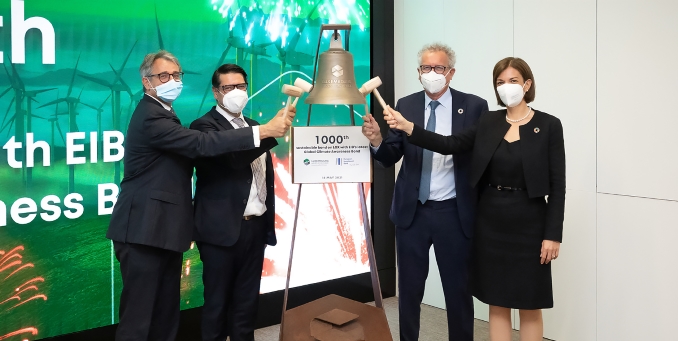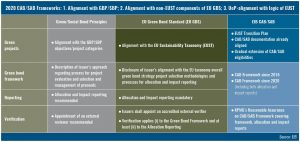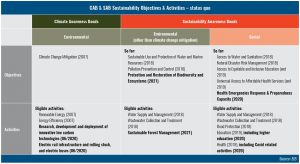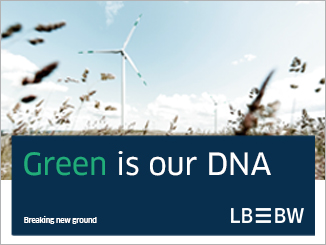The European Investment Bank (EIB) has helped shape sustainable bond issuance from its first Climate Awareness Bond (CAB) in 2007 to the recent arrival of the Taxonomy. Head of sustainability funding Aldo Romani and sustainability funding officer Johannes Heidbrink discussed the philosophy behind the supranational’s strategy and the latest market developments with Sustainabonds’ Neil Day.

Pictured: On 18 May, Aldo Romani, Ricardo Mourinho Félix, EIB vice-president for funding and treasury, Luxembourg Minister of Finance Pierre Gramegna, and Julie Becker, LuxSE CEO, celebrated the EIB’s $1.5bn 10 year CAB being the 1000th bond listed on LGX.
You can download a pdf of the interview here.
Neil Day, Sustainabonds: The EIB supported the introduction of an EU Taxonomy. Following at times difficult discussions, the first key part of this was finalised last month. Does it deliver on a scientific basis what is necessary? And is it done in a way that makes it possible to help grow green finance?
Aldo Romani, EIB: The answer that I can sincerely put forward is, yes. And it’s yes based on my views as a market participant.
The experience of the past few months tells us that this has indeed been a very difficult exercise, but I must say, personally as a European citizen, that what has happened in the past three years has rekindled my trust in the value of European institutions, and in the capacity of the European Commission to achieve something meaningful, something that could not have been realized otherwise.
The value of the exercise that the Commission has put in motion is that it is building, by way of a comparison of relevant opinions from representatives of multiple constituencies in markets, science and society, a line of tangency that factually describes where consensus lies with regard to what is really essential and can be accepted as common ground in this field.
Even if you listen to our experts talking to each other, you realise that there are so many different aspects to environmental matters that you can have different opinions on them. This was born out, for example, when in 2017 we asked them to map the China Green Bond Endorsed Project Catalogue and compare it with the Common Principles for Climate Mitigation Finance Tracking that the MDBs and the IDFC agreed in 2015. After this comparison exercise, we engaged in a discussion with external reviewers and other international financial institutions to try and devise a methodology that would establish core principles of a common language, with a classification system and core indicators that could be shared. But the result of that exercise showed us that it was not possible to achieve this kind of process just on the basis of our own initiative as market practitioners, not even with the support of the technical expertise that the EIB has in house. There are too many different views and interests.
But the draft EU Taxonomy Climate Delegated Act that was published end of April shows that it is possible — in spite of all the political controversies and different opinions — to build a reference framework that people can use. And the intervention of the Commission proved to be essential in that it can conduct this gently forced process, eventually leading to a common platform of understanding.
I would say that at this stage, the EU Taxonomy Regulation itself is possibly even more important than the Taxonomy criteria, because the Regulation has established a logic, a framework for the way in which people should work. Even if certain areas are not covered and this is the result of political compromise, people for the first time have a handbook addressing the relevant areas that they can work with — which is already more than a lot.
The Commission has taken the initiative in its role as guardian of fair competition, which is an area where it has exclusive competence, and indeed in this respect, the market benefits. The market cannot function properly if everybody is in a position to define by themselves what is sustainable, what is green, so the Taxonomy is an essential component for the efficient working of capital markets. This is why the Commission has been able to put in place a Regulation that has immediate application at national level — contrary to a Directive, there is no need for further intermediate legislation at national level.
So all in all, this is an important step forward. And the moment you make progress in one area, the potential for progress in other areas improves, because people understand that there are strategic advantages in implementing the newly established framework with a sense of urgency. People realise that the framework has a chance, and that if they move faster, they can build a competitive edge over those who move more slowly, inter alia because by anticipating developments correctly, their credibility grows. And so if you adopt this logic, you need to adapt accordingly.
Day, Sustainabonds: To what extent has the development of the Taxonomy influenced the EIB’s overall activities and its Climate Awareness Bonds (CABs) and Sustainability Awareness Bonds (SABs)?
Romani, EIB (pictured): As an issuer that is particularly active in this market and has a responsibility vis-à-vis the EU as the bank of the EU and, more than that, the climate bank of the EU, you need to put in place a bootstrapping approach that uses what is available at all times to lead the way and move forward in the direction indicated by the legislator — as just described — and most recently that has meant following the logic of the EU Taxonomy Regulation.
 Back in 2016, the EIB was invited to intervene in the discussions of the High Level Expert Group (HLEG) on Sustainable Finance and the Bank decided that it should be the capital markets department representing the EIB in this working group, because it was clear that the Commission was trying to generalize and institutionalize what we had begun in 2007 in terms of mainstreaming sustainability into funding considerations. We could then follow the whole debate and provide the input of our market-based experience in addition to the Bank’s project evaluation expertise. So when it finally came to the announcement in March 2018 of the Action Plan on Financing Sustainable Growth, it was clear to us that it would not be possible for the bank of the EU, the bank that was to consolidate its role as the climate bank of the Union, not to align its lending and funding activities with a taxonomy that was recognised as the first priority of the Action Plan, and was supposed to embed the objectives of the EU in the area of sustainability in a way that capital markets can understand.
Back in 2016, the EIB was invited to intervene in the discussions of the High Level Expert Group (HLEG) on Sustainable Finance and the Bank decided that it should be the capital markets department representing the EIB in this working group, because it was clear that the Commission was trying to generalize and institutionalize what we had begun in 2007 in terms of mainstreaming sustainability into funding considerations. We could then follow the whole debate and provide the input of our market-based experience in addition to the Bank’s project evaluation expertise. So when it finally came to the announcement in March 2018 of the Action Plan on Financing Sustainable Growth, it was clear to us that it would not be possible for the bank of the EU, the bank that was to consolidate its role as the climate bank of the Union, not to align its lending and funding activities with a taxonomy that was recognised as the first priority of the Action Plan, and was supposed to embed the objectives of the EU in the area of sustainability in a way that capital markets can understand.
So in September 2018 the Finance Directorate of the EIB decided to dedicate a full team to the development and the issuance of Climate and Sustainability Awareness Bonds. The first thing our team then did was to launch a product complementary to our franchise product, CABs, namely SABs. One of the conclusions of the HLEG final report in January 2018 had been that sustainable development is not just climate change mitigation — which we had previously focused on via renewable energy and energy efficiency projects — but is also other environmental objectives, and it is also social objectives, so we needed to have a product covering these areas by extending the CAB approach.
It was also natural for us to take on board the core principle that we had contributed to developing in the course of the HLEG discussions, which was not to take a sectorial approach, as everyone — including ourselves — had done before, but to follow the new logic that what counts is the substantial contribution of an economic activity, whatever the sector, to a clear sustainability objective. That is why we also changed, upon issuance of the first SAB, the use of proceeds of the bonds to say the allocations will be aligned with evolving EU legislation on sustainable finance, thereby effectively establishing at a very early stage this link to the Taxonomy Regulation.
This is a clear example of our strategic prepositioning in a changing environment. In this way, we effectively created a new model, according to which whatever the status quo of our two products, we would be able to develop them in the course of time to the extent that the bank would apply the logic of the Taxonomy Regulation to its lending activities.
The whole bank then started to move in the same direction, in the first place our Projects Directorate, from December 2019, because at that point in time there was an agreement between the co-legislators on the Taxonomy Regulation and it was clear that it would become reality. The project evaluation experts developed a transition plan to the Taxonomy as reflected in the EIB Group Climate Bank Roadmap 2021-2025 that EIB published last November. This document outlines our intended actions to support the European Green Deal and help make Europe carbon-neutral by 2050. With this strategic plan, we notably connect sustainable funding and lending within the framework established by the EU Taxonomy Regulation, and we will be able to reflect this to capital markets by a further extension of scope in CABs and SABs.
The first results came to fruition visibly in June last year, when on the date of the adoption of the Taxonomy Regulation we were able to launch a €1bn 2035 CAB that heralded a first wave of eligibility extensions. CAB-eligible projects were extended from renewable energy and energy efficiency to further areas contributing substantially to climate change mitigation: low carbon transport and innovative low carbon technologies. Eligibility extensions had already been announced on the SAB side, notably with regard to Covid-related and higher education lending activities. This development had two main effects. First of all, an enlargement of the pool of eligible disbursements allowed for an increased issuance volume; in fact, last year we issued more than twice the amount of CABs and SABs as the year before, 15% of a €70bn-strong total funding programme. And secondly, these concrete initiatives made our long-lasting strategy tangible, ergo credible to investors.
Since the Taxonomy Regulation entered into force, investors have started to recognise that what we were saying previously deserved attention. This has enhanced the quality of our dialogue with investors enormously, because people now ask for a focused presentation on our strategy, not only in the form of two or three pages at the end of a broader presentation on the usual subjects that are relevant for the credit merit of the Bank. They are really taking the opportunity to understand what exactly we have been doing. For example, questions concerning the criteria that we have used for the new eligibilities and how we are managing the transition from old to new criteria for the already existing eligibilities.
Day, Sustainabonds: You have discussed progressive alignment with the Taxonomy. As I understand it, the EU Green Bond Standard (GBS) will require alignment of the use of proceeds with the Taxonomy. This involves not just aligning with environmental targets, but also meeting the do-no-significant-harm (DNSH) criteria and other requirements. At what stage do you anticipate having an EU GBS label, if that is what you are targeting, and how might the Standard more generally affect the development of the green bond market?
Romani, EIB: We all know that the concepts of substantial contribution, DNSH and minimum social safeguards are easy to understand, but difficult to implement. But we shouldn’t forget that if the objective is to permit the market to work better at the margin, these concepts must reach a point where they become applicable. So there will be an incremental process. The Taxonomy has never been conceived as a dead table of law; it is something that requires a dialectic process of refinement until it finally works. And to me this is exactly the point.
For us, concretely, in this year’s CAB Framework we clearly state that we have a series of procedures, “environmental and social standards”, that are applied and address exactly the subjects of DNSH. We do not yet have a fully-fledged solution that completely lives up to this requirement. So the objective is to refine these procedures and have them in place by the end of the year, so that they can be applied to all new allocations next year.
I would like to underline the fact that there is a logic to this that is easily understandable, and what we are looking for is a solution that improves the way markets act at the margin, because that is the force that will then move and drive forward the dialectic process that I was mentioning before in an incremental manner. It is not enough to always be critical of things. You need to propose solutions. If certain solutions are not feasible, you need to propose an alternative solution that works. If you want to take sustainability seriously, it is not good enough to just point at the fact that things are difficult — and this goes not just for DNSH, but also for the concept of substantial contribution and the idea of transition.
The purpose of the whole framework that has been put in place is to create a high degree of accountability in these areas. How do you start doing that if you do not at least establish the principle that all economic activities should be measured in terms of their contribution to certain objectives? And how do you judge materiality if you do not have an apolitical, objective description of how things are presently and should develop in the future?
So really this is a call to the responsibility of each market participant and policymaker to get their act together, clarify what is feasible at this point, and try to improve solutions incrementally over time. This is very much a work in progress and everybody can contribute to it with his or her own experience.
2020 CAB/SAB Frameworks: GBP & SBP and EU GBS comparison
Click to enlarge
Day, Sustainabonds: Your first SAB of 2021 coincided with the One Planet Summit and featured an extension of your eligible activities. What was the strategy behind this transaction?
Romani, EIB: Two years ago, the EIB decided to extend its lending target function from mere climate action to include also other environmental sustainability objectives, and our target of increasing “green” finance to more than half of new yearly loans by 2025 refers to both climate change mitigation and other environmental objectives. The latest addition to our SAB Framework in respect of other environmental objectives is “the protection and restoration of biodiversity and ecosystems”, which is one of the environmental objectives of the Taxonomy Regulation that, as discussed, we are progressively aligning with. Again, we are taking an incremental approach here, starting with activities within sustainable forest management — over time we will cover a number of other areas mentioned in the Taxonomy Regulation as the relevant criteria and indicators emerge. This is an example of the organic development of our CABs and SABs, as we seek to reflect what is effectively feasible at any point in time.
Providing public visibility on these subjects via new issuance can help accelerate progress, extending our processes and procedures to new areas and permitting input from our experience into the relevant official working groups. The transaction that you mentioned is a typical example of that. The One Planet Summit on 11 January was an important forum and set the tone for discussions taking place over the course of the year, such as the high level summit on biodiversity in China. After having prepared the scope extension with our project experts last year, we — on the capital markets side — tried to make the relevance of this debate clear to capital markets by launching a transaction that makes our efforts visible and accountable, and next year we will provide the market with reliable information on how far we have come. Thus, you can see we are taking a very typical capital markets approach on this, trying to combine market conditions and issuance opportunities with focused communications on ongoing organisational as well as institutional developments.
CAB & SAB Sustainability Objectives & Activities
Click to enlarge
Day, Sustainabonds: In March you launched a CAB targeting German savings banks. How do issues such as this fit in with your investor relations strategy?
Johannes Heidbrink, EIB (pictured): What Aldo said is extremely important — the issuance of our bonds is not only a parameter of market dynamics; we also use the issuance of our bonds to amplify core messages and to put the spotlight on important milestones in the field of sustainable finance. This is what we did with the announcement of the extension of the eligibility criteria for the SAB that was issued in January, and also with the CAB in March targeted at the German savings banks sector. In this respect, the Sustainability Funding Team acts as an ambassador for the merits of sustainability funding and investing worldwide.
 The CAB dedicated to the German savings banks was launched in the context of two key events shaping the German ESG landscape, namely the publication of “The commitment by German Savings Banks to climate-friendly and sustainable business practices”, and the final report of the Sustainable Finance Committee of the German Federal Government. This was an ideal opportunity for the EIB to engage with ESG-committed bank counterparties (notably the three lead managers: Deka, Helaba, and LBBW), reaching out to investors that have publicly committed to sustainable targets. The transaction raised awareness about EIB’s early application of the EU Taxonomy Regulation and the expected EU Green Bond Standard — and such an approach has been recommended by the German Sustainable Finance Committee. This found fertile ground: it should not be forgotten that German savings banks contributed their views into the HLEG via the direct participation of Deka Invest. Already at that point (2017) we sowed the seeds of a long term cooperation in the field; we thereby aimed to play a role in the development of the German ESG market by promoting a common approach to evolving EU legislation on sustainable finance. The recent transaction is a showcase that will hopefully have spill-over effects.
The CAB dedicated to the German savings banks was launched in the context of two key events shaping the German ESG landscape, namely the publication of “The commitment by German Savings Banks to climate-friendly and sustainable business practices”, and the final report of the Sustainable Finance Committee of the German Federal Government. This was an ideal opportunity for the EIB to engage with ESG-committed bank counterparties (notably the three lead managers: Deka, Helaba, and LBBW), reaching out to investors that have publicly committed to sustainable targets. The transaction raised awareness about EIB’s early application of the EU Taxonomy Regulation and the expected EU Green Bond Standard — and such an approach has been recommended by the German Sustainable Finance Committee. This found fertile ground: it should not be forgotten that German savings banks contributed their views into the HLEG via the direct participation of Deka Invest. Already at that point (2017) we sowed the seeds of a long term cooperation in the field; we thereby aimed to play a role in the development of the German ESG market by promoting a common approach to evolving EU legislation on sustainable finance. The recent transaction is a showcase that will hopefully have spill-over effects.
We believe that a public commitment to ESG standards such as that made by the savings banks is a seal of quality, because stakeholders will hold them accountable for it. We hope that our actions could motivate sustainable investors to make more of such public statements, and perhaps there will be similar initiatives in the future that would allow us to reach out to other complementary universes of sustainable investors with further dedicated transactions of the same kind.
CABs and SABs offer a unique opportunity for the Bank to enlarge its investor universe with repeat buy-and-hold clients, and in order to understand the dynamics around the green investor base, we have started to carefully analyse to what extent an investor is green. We are now internally researching and assessing the greenness of our counterparts, and an important component is whether they have a public commitment to sustainability or an implemented ESG strategy. Inter alia, such an analysis of the investor base allows to measure additionality, the extent to which CABs and SABs enable us to crowd in investors on top of our existing investor base. This is something we achieved on the Sparkassen transaction, in that we were able to address German savings banks who only came on board because it was a CAB. The CAB ideally fitted into their investment policy for the “Depot A” — the investment of own funds, and as such with their stipulated strategy, within the Selbstverpflichtung, to “manage their own investment portfolios in accordance with recognised sustainability criteria”. In the same manner, we were also able to crowd in investors who bought us in the past but have lately been absent because of the general interest rate environment. 97% of the investors could thus be classified as green accounts, which is a fantastic result.
It is our aim to establish and nurture an ongoing dialogue with market participants, bank counterparties and investors on ESG matters, and that is why this transaction was such a good fit with our investor strategy.
Day, Sustainabonds: Part of the increase in your CAB and SAB issuance last year was related to use of proceeds linked to the Covid crisis. Other issuers did likewise and we saw social bond issuance increase sharply. How do you see the outlook for social as we emerge from the pandemic?
Romani, EIB: There was a phase where green was the only important factor, but now people have realised that social is also important. And ultimately many aspects of sustainability are interrelated — the pandemic clearly highlighted the relationship between climate change, the degradation of ecosystems and health issues, but also education issues against the background of the pandemic’s impact on schooling, in both lower and higher education.
So there is clearly a lot of interest, both on the issuer and the investor side, and the pandemic also highlighted to legislators that it is important to consider the social dimension on top. The last version of the Taxonomy Regulation also foresees a report by the Commission, by the end of this year, on the conditions for an extension of the taxonomy approach to social objectives — this follows up on the HLEG final report of 2018, which already said that social objectives should also be considered in the EU Sustainability Taxonomy.
You can apply the same logic of the Taxonomy Regulation for environmental objectives to social objectives, but social is another area where clarity is lacking. It is not enough to just label a bond as social or mention substantial contributions to social objectives; you need to give substance to your claim, you need to qualify what you are doing. However, it is not easy to measure the relative contribution to social objectives. There is a need for a systematic approach in this area and there is a working group within the EU Platform on Sustainable Finance that is tackling this, where the EIB, as an observer, hopes that sharing its direct experience on this topic can be of benefit. Within the context of the capital markets, people who have expertise and experience in this field need to take the discussion forward in a pragmatic manner.
Day, Sustainabonds: Germany developed a “twin bond” concept for green Bunds with an eye on potential illiquidity in issuance. What are your thoughts on this strategy?
Romani, EIB: This initiative was a milestone in the sovereign space and for the whole market. As you said, the German government explained its twin bond approach last year citing concern around the potential lower liquidity of green versus conventional Bunds, and thus the associated potential spread widening of green Bunds. This was the core concern of the Bundesfinanzagentur and of course as the Eurozone’s benchmark issuer they have to pay attention to this kind of consideration. And it is quite interesting to have the twin bond instrument effectively test that liquidity hypothesis.
For us, the situation is different. CABs are not subject to the same considerations that are relevant for green Bunds. Despite their lower issue size, they tend to outperform — this is based on a very strong green investor bid. They don’t trade that frequently, but — as Johannes mentioned earlier — the investor base is much more stable and strategic than normal and there is definitely more demand than supply, these bonds can be sold at levels that are fairly close to screen levels, even if there is not an ongoing flow in the secondary market. Our experience has always been that green bonds, in spite of their lower size, outperform conventional bonds. So we do not plan twin trades.
Having flexibility in the timing of CAB and SAB issuance allows us both to highlight our leadership role in the implementation of the EU Taxonomy Regulation — as discussed in relation to the One Planet and Sparkassen issues — and also to optimise CAB timing and pricing in a crowded market. One of the issues that we are increasingly facing is that the number of green bond issuers is multiplying and greater volumes are being brought to market, so it is important for us to be able to act in a very flexible manner, really trying to identify the best issuance opportunity.
At times, this can be unconventional timing, as demonstrated by our last CAB, a US dollar global trade. We issued it in a week that is full of Asian holidays, but notwithstanding this it was exactly the right moment to proceed because it was a period that was free of competing supply. The full attention of those markets in Europe and Asia that were open was on our deal and we were able to achieve a book four times as large as the final issue size of $1.5bn, despite the fact that Japan, for example, provided only a limited contribution. And, by the way, we were once again able to use this CAB to mark a milestone in the development of the market, since it is the 1000th bond with a focus on sustainability listed on the Luxembourg Green Exchange.
So one needs to think in a less conventional way about timing and try to use opportunities when they materialize, ideally when there is no competing supply. This flexibility and the detachment of our CABs and SABs from the benchmark issuance of the Bank are important for us.
Day, Sustainabonds: What is your view of sustainability-linked bonds, which have taken off in the past year?
Heidbrink, EIB: Sustainability-linked bonds are an interesting product that can further crowd in more market participants. They have come to represent a valuable engagement instrument for many issuers that may not, for one reason or the other, have the possibility to issue a use of proceeds bond, so they are to be considered complementary.
For us, transparency in the field of projects selection, allocation and reporting that we provide with our use of proceeds bonds are key. In our view, what counts is the material contribution of the use of funds to the transformation of the economy. And it is really important to be crystal clear with investors as to what exactly you are doing with their funds. This clarity is what we provide with the publication of our CAB and SAB Frameworks, which include both allocation and impact reports and are audited with independent reasonable assurance following the ISAE 3000 standard. This is why use of proceeds bonds are the EIB’s instrument of choice.
Main photo: On 18 May, Aldo Romani, Ricardo Mourinho Félix, EIB vice-president for funding and treasury, Luxembourg Minister of Finance Pierre Gramegna, and Julie Becker, LuxSE CEO, celebrated the EIB’s $1.5bn 10 year CAB being the 1000th bond listed on LGX.
Sustainabonds conducts all research and writing independently to maintain the full editorial integrity of the publication.
As a supporter of Sustainabonds, LBBW is facilitating a series of interviews with leading players in ESG and the green, social and sustainability bond markets.



